The Moving Targets Skill Theme pt 2
VANILLA SECRET 3 & BUTTER BRIDGE 1
Vanilla Secret 3 and Butter Bridge represent two of what I call “variations” on the theme of moving targets. I liken these two levels to a fantasia and a toccata. A fantasia generally means that a music composer—or, in our case, a game designer—creates something that’s based around spontaneity and improvisation. Of course, this is not the norm in classical music or game design. Well-designed games have a lot of room for a variety of techniques, but if the game, section or level is designed too loosely, it’s easy for players to miss the challenge and the fun. (There are a few exceptions, naturally.) In Vanilla Secret 3, however, the designers just decided to throw some things together with only loose organization and let the player sort it out.
There are some ordinary, cycling platforms that stay in place in this level. That, however, is not the fun part. What you see on the right is these waves of dolphins that move in a kind of sine wave shape across the screen. These platforms are so clustered it’s that there’s no clear optimal path. Instead, the player has to improvise.
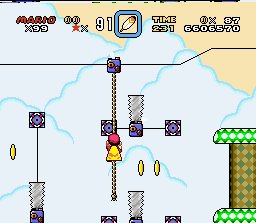
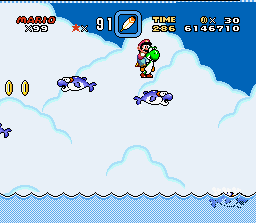
There’s also barely any penalty. The puffer fish which lurks in the water is technically dangerous but it’s easy to avoid even in the water. Then of course there’s all the water; this takes the penalty out of the jumps in the same way it did in the early Yoshi’s Island levels. Falling has only a small risk of damage, and little risk of dying. This level is also one of the shortest in the game, in terms of the number of identifiable challenges. There’s not a whole lot between Mario and the end-goal, except a lot of room to improvise.
Sticking with the musical metaphor for a moment, we examine the level which is more like a toccata: Butter Bridge 1. A toccata is a musical piece designed to show off an instrumentalist’s skill. A toccata can be beautiful, but the first goal of such a piece is to allow the performer to display technical skill in flashy, obvious ways. (Subtle flourishes may also be included, but they aren’t the point.) In order to achieve this sense of flashiness the toccata often will include things that are obviously difficult, unusual, and sustained. This is the perfect description of Butter Bridge 1.
The first thing the player will notice about Butter Bridge 1 is that the scrolling camera controls the pace of the level. This makes it easy for the designers to force waiting periods and precisely timed jumps, which fit with the current skill theme. What it does not do, however, is make this process easy. The slowly-scrolling camera forces the player to wait, but the tipping-scale platforms in this level make waiting deadly. And this is to say nothing of the fact that all of them have a width of only two blocks.
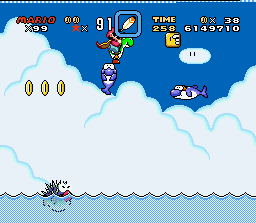
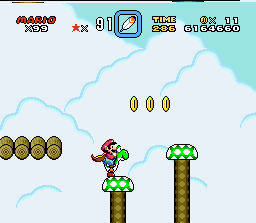
The platforms sink at a rake of about one coin-block per 15 frames, with a corresponding rise in the platform which makes up the other end of the scale. The tricky part about this is that not only does the filled platform sink, but the opposite platform rises, meaning that for every 15 frames that Mario occupies one of these platforms, the delta-height of the next jump increases by two. Considering that the camera may not always reveal the platform yet to come, this configuration can quickly put Mario in a position he cannot escape. When not occupied, the platforms will return to an even position, but at a rate of about 40 frames per 1 coin-block—much slower than the damage is done (although if the platform has sunk less than 1/10 of a block, it seems to reset more quickly).
The tipping-scale platforms are unique in Super Mario World, but are not the level’s only curiosity. At a larger structural level, we encounter another bit of strangeness which fits the toccata metaphor: most of the challenges in this level come in an unbroken chain. Whereas a typical level breaks up its expansions and evolutions with empty platforms, punctuating challenges, or even crossover challenges, Butter Bridge 1 simply puts all of its challenges in a row, such as this monster:
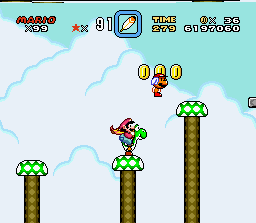
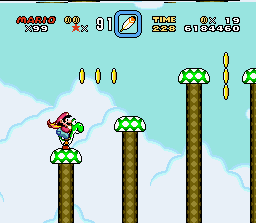
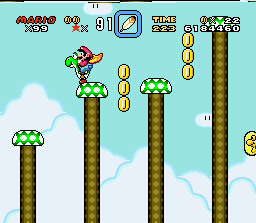
The difference in height means this is an expansion. The fact that the player has no break seems like it should be an evolution—but this is one place in the game where this classification system falls down. This part of the level doesn’t look or act like anything else in the game, really. And the sustained action makes the level seem considerably harder than it really is; all the player really needs to do is repeatedly jump and cape-glide back down without changing platforms. The platforms’ return to equilibrium is not fast enough to preserve equilibrium indefinitely, but a player constantly jumping and gliding back down will avoid problems. Jumping between the two platforms while gliding can accomplish this even better, while waiting for the screen to scroll. As noted, though, the level gets much easier after a few playthroughs. This is where the toccata comparison is most telling. A toccata displays the performer’s talent by sustaining odd and challenging musical passages at unusual length. This, Butter Bridge 1 does. What Butter Bridge does not do, however, is impress an audience. After a few playthroughs, the player will master the skills for the level and it will be easy; it will also look easy. After all, the d-distances between platforms are rarely more than 3 blocks. There are occasional periodic enemies patrolling between jumps, but they often make the jumps easier, because the player can bounce Mario off of them, shortening the only two jumps in the level that are wider-than-normal expansions. There’s nothing visually impressive about it, for all its initial acrobatic terror.
Although many of us who have played this level remember it for the second-by-second frustration it gave us, Butter Bridge 1 is one of the shortest levels in the game by total lateral distance, and none of the jumps are particularly far in either direction, if the tipping scale mechanic is handled correctly. Mastery of this level, however, looks and feels impressive even to the player who has realized just how easy it really is. A good game cannot always tell players how much they have to learn; sometimes it’s necessary for the game to tell them how far they have come.
FOREST SECRET AREA
Forest Secret Area doesn't do that much in the way of a cadence although it’s very clearly a moving targets level. What's here is cleverly organized along thematic lines, just not in a real cadence—but the themes are so stunningly clear here that it almost justifies the lack. The only problem is that it's way too easy for the player to break that organization and never see the thematic appropriateness behind it. You might say that this level is art for the artist’s sake, which is always a questionable decision. Nevertheless, there’s a lot to learn from it as long as we’re studying game design. The level contains two platforms at the beginning: front and back. The choice of platforms gives the player subtly different experiences, assuming the player rides only one for the whole way to the goal. The front platform will take Mario through a series of lateral encounters with intercepts with an emphasis on action solutions. In these two spots pictured below, the approaching Wing Koopas will almost pin Mario down beneath the coin-blocks, making his jump haphazard or simply interrupted.
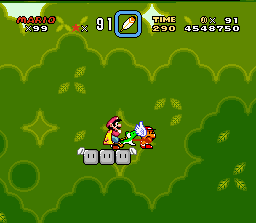
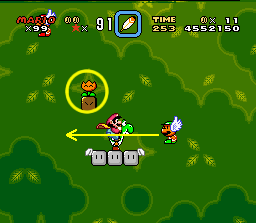
The easiest solution to this is to use fireballs to knock out the oncoming Wing Koopas in one shot, and coincidentally enough this path takes Mario past a block which will grant one. The thematic material is obvious: this is the intercepts theme at its most action-oriented. I can’t see why this is plugged into a moving targets level where it’s so easily overlooked, but the designers took a risk here and it didn’t go horribly, at least.
The back platform, if ridden the whole way, will still encounter intercepts, but will emphasize jumping solutions and provides a feather powerup. Note that I call them intercepts because the player is, in a sense, in a continuous jump as the platform moves up and down. The effect isn’t particularly challenging, but it does simulate intercept-like situations, even if the enemies don’t fit the strictest definition.
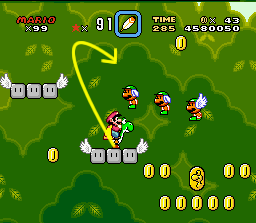
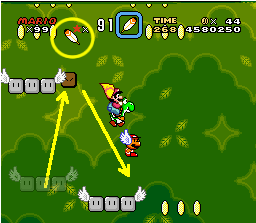
You can see how, as the platform rises into these Koopas, Mario is forced into an off-platform jump and glide, most likely a back-jump and possibly an enemy bounce. In the first case, the period of the enemies is essentially non-existent (if they turn around, it happens off-screen), but their quantity forces Mario to jump somewhere clear of them: off the platform. The second challenge is a kind of insidious mutation of this: there's only one Wing Koopa but he's on a very short patrol and so has a similar effect.
Both platforms take Mario through this L-shaped intercept trap, but their approach angles make a lot of difference. The fire-flower path takes Mario up into them, revealing the three laterally-flying Wing Koopas first, and offering a clear shot at them with fireballs.
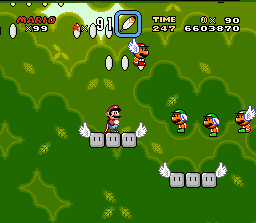
The feather platform path brings Mario in from overhead, offering a shot at jumping on the vertical Wing Koopa before descending with a glide onto (or past) the other three.
The thematic material in this level is delivered so elegantly, so it's a shame that the level's two-platform style makes it so the player will probably never perceive this elegance. The intersections of the platform can’t help but suggest a transfer from one platform to another. After all, most of the game's content is delivered as Mario hopping from one platform to another. But only by ignoring this impulse (and perhaps playing the level twice in sequence) can the player actually get the most coherent experience of the level. It’s just not likely.
ROY'S CASTLE
Roy’s Castle is an interesting take on the tracked content idea from the two bridge levels the player has faced so far. Like Butter Bridge, this level is actually quite short, but because it introduces a mechanic not yet seen in the game, it seems much more difficult at first than it really is. Mario is forced to ride what might be called a caterpillar platform. The platform moves, but does not carry Mario with it, so the player needs to constantly walk Mario along the length of it in order to stay above the lava below. The challenge lies in the fact that this platform takes many different shapes, and moves in many different directions. The unpredictability of the first few attempts makes it seem hard—but ultimately there are only really 4 challenges while on the caterpillar platform, and none of them are particularly complex.
Before we examine the challenges individually, however, it’s important to point out three level-wide design considerations. Most of the d-distance for this level is over lava, and so most of the missed jumps will be fatal. There’s also no mid-gate, so all failures will result in the player having to completely re-attempt the level. Finally, there’s a very important shift in skills that’s taking place in this level. Up until now, the core skill of the moving targets theme has been the timing jump. That’s still true. But before Roy’s Castle, this skill was typically supported by the cape-glide and the back-jump (sometimes both together). In other words, players could afford to make more mistakes than they can in this castle, because skilled use of the cape could allow players to recover. Since Cheese Bridge, that recovery has been getting harder and harder, and now this castle completely negates that ability, because the caterpillar platform travels very quickly and often in erratic paths. Cape gliding will only result in a stranded, doomed Mario slowly gliding into lava. Back-jumping is basically impossible unless the player has the platform’s path completely memorized, and if that’s the case, why do they need a back-jump at all? What replaces these skills is the controlled-height jump, which is going to feature more and more prominently as the moving targets theme (and the game as a whole) reaches its climax.
The first challenge sees the platform contract and change shape, taking the form of a staircase. The difficulty lies in the fact that until this challenge the platform had moved in a quick but mostly straight path so that Mario could just walk. Simply walking with the platform is the standard challenge for the level. Now, though, Mario has to jump, although he is faced with two complications. The first complication is that the bottom step of these stairs is always disappearing because of the platform’s constant movement. The second complication is that because of the stair shape, half the platform’s width is now of no use to him. Essentially, the platform has gotten smaller and changed shape, forcing a timed jump.
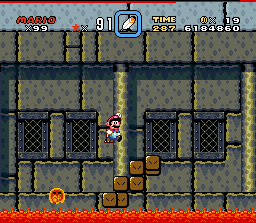
The next challenge is different, and involves no jumping, but is still tricky. The platform bends around several times.
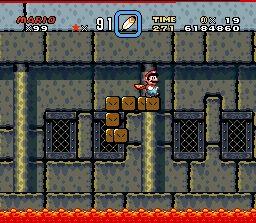
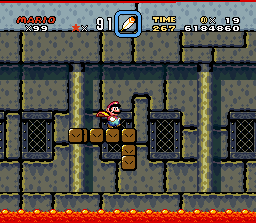
In this case, the player is being tempted to simply overrun the platform. The platform will extend 11 blocks straight out—a distance that the player is intuitively used to by now. The player will be tempted to go into a full run on those 11 blocks, but the platform turns immediately downward resulting in a pitfall. What the designers are doing here is to manipulate the player’s most important skill in this skill theme: prediction. The timing jump—the core skill of this theme—involves predicting regular motion. This platform, unlike all that have come before it, is not regular in the same sense the others have been. The skill betrays the player, until a few deaths have made him or her cautious.
Next we see another staircase challenge, although a bit longer. This staircase comes with a typical evolution challenge: add a periodic enemy to a timed jump. These four bouncing fireballs are almost an intercept, in that they cause the player to modify Mario’s jump-path. But the player is still going to be using periodic enemy skills in predicting the path of this undefeatable obstacle—walking rather than jumping. The designers already introduced the fireball in a kind of warning-shot display, as one of them coasted by the player, revealing its bounce-properties earlier in the level.
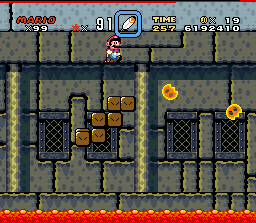
With this knowledge, the player is going to have to guess where these new, dangerous fireballs will bounce, and at what angle. It’s not a test of reflexes, but one of prediction. Fortunately, the fireballs aren’t very fast—although that doesn’t help much when they’re being reflected back and forth between ceiling and platform every second.
One interesting note, much like the falling spikes which will succeed them, the fireballs in this section are not cued by the position of the caterpillar platform. Rather, they are cued by Mario crossing an invisible line. This means that the fireballs can come at meaningfully different times, depending on where Mario is on the platform. The third fireball, in particular, can be reflected off the bottom of the caterpillar platform if Mario is further back on it when he hits the fireball’s trigger point. It’s not a game-breaking flaw, but it does leave one to wonder what the designers had in mind about the player’s probable position.
The caterpillar ride ends with a sequence of falling spikes that are complicated by a damaging ceiling and floor. Players who have not been through Vanilla Fortress (a secret level) may not be aware of the falling spike. Whether by coincidence or design, the designers reduced the penalty in this area so that being knocked off the platform—or panicking and falling—would not necessarily be fatal. Mario can still hop back on the platform, although it won’t be very easy.
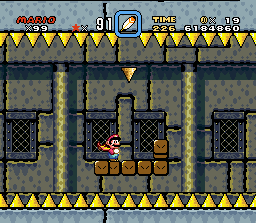
Want to read more? The rest of this section can be found in the print and eBook versions.